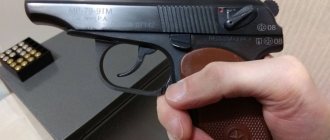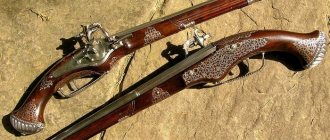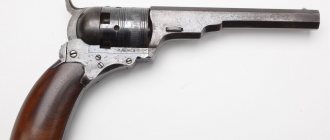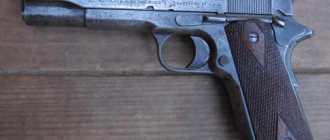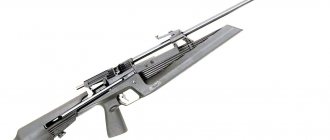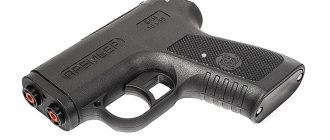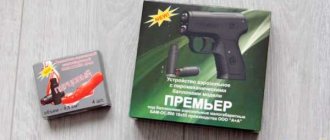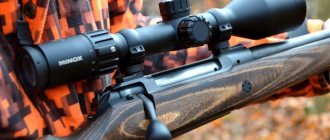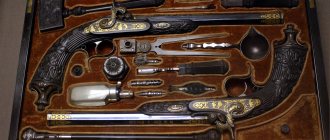To ensure the safety of themselves and their loved ones, people are forced to purchase pistols for self-defense. Most often these are traumatic and pneumatic weapons. It does not allow serious harm to human health, but can stop an attacker from committing illegal actions. Some types of weapons are used not for self-defense, but in sports. They allow participants to signal that the competition has begun. These models include a starting pistol. Regardless of what weapon the user purchases, you need to be able to choose it. To do this, when purchasing, you should be guided by certain criteria, which we have given below. In addition, we have compiled for you a rating of the best pistols of different types, from which you can choose the appropriate option.
Tips and tricks when choosing a pistol
When choosing a pistol, consider the following points:
- operating principle. The following types of pistols are distinguished: spring-piston, gas-cylinder, compression, and chambered for Flaubert cartridges. The first type has a low rate of fire and strong recoil, so it is not suitable for beginners. The second type is the most common. It is characterized by good range and sight accuracy, but regular use requires constant gas refilling. Compression models will have to be refilled frequently, and pistols chambered for Flaubert cartridges make a sound when fired like a military weapon;
- barrel design. There are two options for trunks - smooth, rifled. The first ones are low in cost, but they have a worse firing range and sight. The latter are characterized by high accuracy and firing range, but have a high price;
- type of projectile. There are two types of ammunition - balls and bullets. The former are distinguished by high penetration ability, but have low hit accuracy. The second ones are characterized by accuracy of hits, but they are less dangerous;
- erection and injection system. Pistols come in manual and automatic designs. The former have a low cost, while the latter are easy to use;
- fuse. They come in two types - manual and automatic. Pistols with the first type are cheaper. However, each time the fuse will have to be installed manually. The second option will not allow you to use the weapon unless certain conditions are met, but such models are more expensive.
Video - Inexpensive air pistols
So which pistol should you choose? It all depends on what type of weapon is needed. So, if you need traumatic pistols, we can recommend the Cybergun PM (MAKAROV) option. Among the pneumonic models, we recommend the product MP 654K-32-1. In our rating, you can choose any suitable option both in terms of characteristics and price.
I was struggling with the same question about a year ago. 1. mr 80-13t .45 Rubber www.baikalinc.ru/ru/company/322.html
advantages: - 6+1 - possibility of replacing the magazine - familiar with the structure and operation - availability of holsters - flat - can train with PM-shaped pneumatics
cons: - there are known cases of damage to the chamber and barrel after firing about 200 rounds (the main disadvantage, I fired over 300) - there is no way to strengthen the barrel with a coupling and sharpen the teeth with a file (they are not welded) - by law you cannot carry a cartridge in the chamber
2. warrior 410x45tk akbnn.ru/ratnik410.php
pros: - no precedents of breakdown (the ladies at the entrance said that after a triple load of gunpowder they had to knock out the drum with a hammer, the steel sleeve was torn, but there are no steel drums without grooves...) - no teeth or narrowings - easy to clean
Cons: - 5 rounds and cannot be reloaded quickly. Will five be enough if, according to statistics, a man is attacked more often by three people and one cartridge is not enough for one attacker, and besides, you can miss out of fear? — very few types of holsters. there is no intra-waistband at all (as it turned out, it is not needed at all, a leather stitchpro without a fastener and a plastic stitchpro are enough) - thick and large - killer sighting (but at the market they say that self-defense occurs more often up to 2-3 meters or does not happen at all...) - there are no spare parts and the workshop in Nizhny Novgorod, for example, does not have them. If it's broken, throw it away.
3. OCA
pros:
- powerful and recognizably dangerous (gopnegs know the dumpling maker) - almost as thick as PM (checked) - does not cling to the pocket with the trigger and the whole thing - can be bought for 3000 rubles with 3 rounds fired - in an extreme situation a la “forest loss” you can fire rockets like a flare gun
minuses:
— electric ignition of gunpowder in a cartridge case is practically not used by the military. Is it really not as reliable as Kalashnikov magazine lies in its laudatory articles about the wasp? - there are few normal holsters - incredibly expensive cartridges make it impossible to train (100 rubles - wasp, 35 rubles - .45 rubber, 50 rubles - .410) - does not develop the correct motor skills for handling the PM, which will be given “at the military registration and enlistment office”
all sorts of T12
minus - I don’t have money for it, never have and never will
GENERAL DISCUSSIONS:
1. you need to train dry for 15-20 minutes every day (I do it once every 5 days and that’s bad)
2. you need to train with a friend in “role-playing games” and scroll through different situations on the ground in your head
3. clothing and behavior must adapt to the injury, otherwise the injury is not necessary
4. Trauma is a heavy and angular piece of iron that crushes the side of the body every day, you need to carry it in the same place, otherwise you will get tangled in your hands. this place is on the right side.
5. People with injuries are not allowed in everywhere and often have problems at train stations and in the subway.
Voting for the best gun
Which pistol would you choose or recommend?
SHP pistol Retay S2022 (Sig Sauer) 9mm PAK
0.00 % ( 0 )
Signal pistol Walther PPK mod 007 with moderator
22.22 % ( 4 )
MP 654K-32-1
0.00 % ( 0 )
PCP Ataman-M1U
0.00 % ( 0 )
Stalker S84 4.5 mm
0.00 % ( 0 )
Gunter P40
11.11 % ( 2 )
Baikal MP-654K 20
11.11 % ( 2 )
Gletcher CLT B25
0.00 % ( 0 )
Borner PM-X
11.11 % ( 2 )
Cybergun PM (MAKAROV)
11.11 % ( 2 )
Borner TT-X (4.5 mm)
16.67 % ( 3 )
Gamo Pneumatic Gp-20 Combat
5.56 % ( 1 )
ASG Bersa BP9CC, 4.5 mm
5.56 % ( 1 )
Gletcher NGT F Silver, 4.5 mm
5.56 % ( 1 )
Baikal MP-53M, 4.5 mm
0.00 % ( 0 )
Introduction to the topic
Citizens of the Russian Federation are endowed by the Constitution, namely Part 2 of Article 45, with the right to protect their interests by all available means permitted by law.
Also in the Law of the Russian Federation “On Weapons” in Art. Article 24 states that citizens may use weapons within the limits of necessary defense or extreme necessity to protect their life, health and property. Legal means of self-defense in the Russian Federation are:
- electric shockers,
- gas canisters and spray throwers,
- gas revolvers and pistols,
- firearms of limited destruction.
In addition, special non-lethal ammunition is produced for hunting shotguns - rubber buckshot. However, it is practically useless and effectively fouls the barrel of a weapon.
Important!!! The goal of self-defense is to carry out such actions in which the attacker will stop his criminal acts. Causing harm to him is not the purpose of self-defense.
Consequences of using a pistol
The legislation of the Russian Federation establishes the following:
- The use of weapons is possible if this is the only way that can prevent a crime.
- Before using a weapon, the attacker must be warned that if he does not stop his criminal actions, the weapon will be used against him.
- After the weapon has been used, regardless of the result, the shooter must call police officers, as well as representatives of emergency services, before they arrive, provide first aid to the attacker and collect contacts of witnesses to the conflict.
And it's all?
Which air pistol is more powerful is not so easy to answer. It also turned out to be difficult to create an objective power rating. It is impossible to go through all the variety of pistols produced nowadays. As a rule, in the class of inexpensive pneumatics, the most powerful pistols are those with a moving barrel. Therefore, when buying a powerful barrel, forget about accuracy. The samples I recommend confirm this. Of course, there are other powerful representatives, especially in the field of multi-compression pneumatics, but narrow lines of powerful gas cylinders were found only from two manufacturers. For example, among those used in small quantities in the hardball environment you can find the multi-compression Crosman 1377:
There are other representatives of multicompression:
"Veles", 220 m/s per half gram
Features of using air pistols
In a situation that requires quick action, air guns are not the best option. Before use, it must be removed from the holster and charged. If you carry a charged model (which, in theory, should not be the case), the gas from the cartridge is gradually etched and requires periodic recharging.
The stopping effect of the pneumatic gun is not very great due to its low power. For maximum defensive effectiveness, the attacker must aim at exposed parts of the body. However, causing bodily harm to another person may be legally punishable in the event of legal proceedings.
Traumatic pistols
Firearms of limited destruction or traumatic are produced in the form of pistols and revolvers. It is designed to fire a cartridge with a soft striking element - a rubber bullet. Which, in theory, when fired, should cause non-lethal damage to the attacker, while forcing him to stop the attack.
As practice shows, the use of OOOP either has no effect on the attacker or leads to his death. In the event that aimed fire is opened at the head, then with a high degree of probability this will lead to the death of the attacker, which is confirmed by judicial practice, since a rubber bullet has sufficient energy to break the skull bone.
In the event that the fire is directed at the arms or legs of the attacker, the likelihood that the shooter, who is in a state of stress, will hit the target is extremely small. In addition, a bullet hit in the leg or arm will not have enough effect to stop the attack.
Gun power
This indicator can only be considered in relation to traumatic weapons or PCP air pistols. For traumatic weapons, the legislation introduced a limit of 91 J; higher energy can only be allowed in service weapons, for example, the “Shaman” pistol has a muzzle energy of 120 J.
It makes no sense to consider other types of pneumatics, except PCP, since they have too low energy, ranging from 3-7.5 J, which is clearly not enough to cause any noticeable harm to the attacker.
Important!!! As a reminder, the goal of self-defense is to stop the attack, not to harm the attacker.
The energy of PSR pistols is enough to cause serious bodily harm, but it will not be possible to stop the attacker, since the bullets have a high penetrating effect and a low stopping power.
Obtaining permission to carry and store weapons
To obtain permission, you must first undergo a medical examination and obtain a certificate in form 046-1. Then you need to provide the following to the OLRR:
- statement;
- copy of passport;
- received medical certificate;
- 2 photographs 3x4 cm.
After which the applicant will be sent to a weapons safety training course and to a local police officer. In addition, the applicant must pay a state fee and within a month a decision will be made whether to approve the application or refuse it.
What is the best air pistol for self-defense?
When choosing a pneumatic gun for self-defense, there are many different factors to consider.
Of course, it is necessary to take into account the technical characteristics and quality of the material used to make the case. Products with a plastic exterior can also have high performance capabilities. It is important to ensure that there are no plastic parts in the firing mechanism. Their presence can negatively affect the reliability of air guns.
Features of choosing bullets
There is a large amount of ammunition for self-defense weapons on the market, the following types can be distinguished:
The 9 mm RA cartridge is the most common cartridge, also because it is used in the MP-79-9TM. Its main drawback is a very light bullet of 0.7 -1 grams. This cartridge is produced by Tekhkrim, KSPZ, AKBS, Oil Refinery and KHZ;
The 380 ME GUM cartridge is used in revolvers; its power is significantly inferior to its pistol counterparts due to the fact that revolvers are structurally weaker and the use of powerful ammunition will lead to the destruction of the weapon. This cartridge is produced by NSZ, Tekhkrim and AKBS;
- The 10x22T cartridge is also widely used, like the 9 mm RA. It has good efficiency, especially if you do not use it on Umarex pistols, since they are not designed for its energy and quickly fail. Produced by Refinery, Tekhkrim, AKBS, Fiocchi;
- The 10x28 cartridge is relatively new for the Russian market, used only in the Grand Power T12, Steyr M-A1 and TT-T. Produced by only one company, AKBS. Due to its high power, it can be used in service weapons, where legislative restrictions on muzzle energy are not so stringent;
- 10x32T and 10x32TM cartridges are used in the Leader pistols and the Naganych revolver. A special feature of this ammunition is that it uses 2 propellant elements;
- cartridge 11.43x32T is one of the best in its class;
The 18x45 cartridge is used in the Osa PBA, and is the oldest cartridge on the market, and yet its effectiveness is not disputed by anyone.
